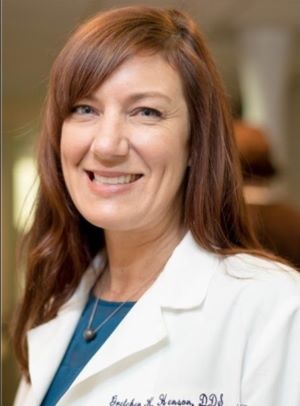Enter your email to receive the CareQuest newsletter:
October 9, 2023
Throughout her career, Gretchen Henson, DDS, has provided personalized prevention recommendations for patients, knowing that they all have different backgrounds and lifestyles.
“I spend so much of my appointment trying to figure out what their home life looks like, so we can tailor a plan for them,” Henson says.

Henson does her work as the only pediatric dentist at River Valley Health in Williamsport, Pennsylvania, without using oral sedation, general anesthesia, or an operating room. She does not have pediatric-trained dental assistants — her two dental assistants were hired to work on adults. Instead, she leans on minimally invasive care.
“It’s imperative that I can work with SDF and glass ionomers because I can’t put the kids under in any way,” she says.
Henson knows that not everyone in the oral health industry is using these strategies and protocols just yet. A CareQuest Institute webinar she attended, “Managing Dental Caries: Evolving Strategies and Proven Techniques,” helped reinforce what she has been doing for years — and strengthened her desire to help spread that knowledge.
The Latest in Caries Management Strategies
On the webinar, three experts (Erinne Kennedy, DMD, MPH, MMSc, assistant dean for curriculum and integrated learning, College of Dental Medicine, Kansas City University; Sandra Guzman-Armstrong, DDS, MS, clinical professor & advanced education program director, College of Dentistry & Dental Clinics, University of Iowa; and John Frachella, DMD, pediatric dental consultant) discussed how to provide personalized prevention recommendations for patients. They explored how to use various strategies for managing dental caries and how to avoid a one-size-fits-all approach by implementing nonsurgical and nonrestorative protocols.
The experts were speaking Henson’s language.
“I learned from [Dr. Frachella] about using the structure within the teeth that most dentists would cut away, keeping it as a scaffolding to build off,” Henson says. “That’s something I’ve been doing for years . . . I know it works, but it was nice to hear him say that. I liked the way that he discussed things being like chemotherapy, because chemotherapeutics may leave a void in a spot, and that’s okay. Absence of pain is a good marker, and restoring the tooth to form and function is a good marker.”
Henson says she’s passionate about increasing access to care and using techniques that are safe, effective, and tolerated by children. She says dentistry traditionally has been taught to include a set of aesthetics that don’t apply, for example, to the clinical and radiographic results of a Silver Modified Atraumatic Restorative Technique (SMART) restoration.
“And when well-intentioned dentists aren’t taught the chemistry behind it, then it’s really difficult to explain,” she says. “The x-ray may look like recurrent caries, but you’d say, ‘No, don’t reenter that tooth. It’s healing, or it’s healthy, or it’s stable.’”
Henson’s Path to Personalized Prevention
Before coming to River Valley Health, Henson worked for three years helping refugees in Arizona and spent six more working with patients and residents in New York.
“The reason I made this jump [to River Valley Health] was because I have a family member who lives out here, and I knew they were in need of a pediatric dentist,” Henson says.
Before she came to River Valley Health, patients were being sent to two other practices that were a one-to-two-hour drive away. The waitlist for those offices stretches to spring 2024.
“One of my colleagues, Jack Dillenberg, DDS, MPH, used to say, ‘Bring dentistry to where dentistry doesn’t exist.’ And this was an opportunity to do that,” she says.
Many of the children and families Henson works with are insured through Medicaid and face numerous barriers to accessing dental care. Minimally invasive care, she believes, can help improve outcomes for those children.
“The general dentists in this area do not take x-rays on children, so the decay doesn’t show up clinically until they’re 7 years old or so, and then, all of a sudden, everything’s falling apart,” Henson says. “And suddenly at 6, 7, 8 years old, those interproximal lesions grow big enough that they just fall apart. So, my schedule right now, pretty much, is filled with nothing but emergencies.”
Tools like brush-on therapies are critical for her.
“I put SDF on almost every single emergency kid today just to buy time to get to a slot where I can work on them,” she says. “I do a lot of Hall crowns. I’ve been doing Hall crowns for more than 10 years.”
Henson wants to spread the word about minimally invasive care to others in the industry, starting with a presentation to the dental hygienists at River Valley Health on pediatric dentistry. She also plans to meet with general dentists to show them what teeth that have been treated with brush-on therapies like SDF look like, and to sit down with pediatricians and talk to them about how oral health fits into overall health.
She says her two dental assistants are already working hard to get up to speed on assisting when it comes to pediatric patients.
“I don’t want to be the person that just puts out the fire once it’s started,” she says. “I want to help educate about prevention, too.”